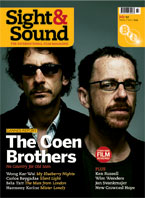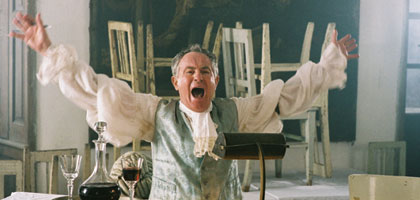Primary navigation


Michael Brooke finds Jan Svankmajer on surreal good form in a horror tale of blasphemous orgies, premature burials, madhouse revolution and raw meat that draws inspiration from de Sade and Edgar Allan Poe
Jan Svankmajer's fifth feature confronts from the start. Before the opening credits, the man himself pops up against a white backdrop to address the audience directly, supplying both a personal credo and an introduction in which he describes Lunacy as an "infantile" tribute to Edgar Allan Poe and the Marquis de Sade. This could be misinterpreted as cynical self-deprecation, except that Svankmajer would not consider the word pejorative at all. Rather the opposite, as he has the highest regard for the way children have yet to be "civilised", a term he treats with undisguised revulsion.
He also explicitly identifies Lunacy as a horror film, which is apparent in its visual approach. A shot of a coffin being trundled through a moonlit wood could have come straight from Hammer, as could the ritualised orgy in the chapel. These indulgences in the genre's superficial pleasures are deceptively light-hearted for the first two acts (the humour, though black as tar, is clearly intentional), but when the film lurches into untrammelled horror in the closing third, the effect is like a punch in the vital organs - and there are plenty of those on display too.
The setting is ostensibly France, though the language is Czech and the period skips blithely from the present day to the late 18th century and back without so much as a by-your-leave to characters acting out a linear narrative. In this, the recently bereaved, profoundly traumatised Jean Berlot (Pavel Liska) is drawn into the world of a charming but sinister individual known as 'the Marquis' (Jan Tríska). Berlot is possibly the only person who will be shocked to find that this involves blasphemous orgies, premature burials and a visit to a sanatorium whose staff seem as demented as its patients.
Lunacy's raw material comes from Poe, one of Svankmajer's long-term influences. In the early 1980s he brilliantly adapted the writer into the short films The Fall of the House of Usher (1981) and The Pendulum, the Pit and Hope (1983), with the first in particular showing an innate understanding of the peculiar psychology of Poe's universe. For Lunacy he drew on the well-known 'The Premature Burial' and the obscure satire 'The System of Dr Tarr and Professor Fether'.
The latter supplies the asylum location and the ideological debate about the most effective treatments for insanity, though Poe's remedies stop at the relatively benign form of humiliation implied by the title. By contrast Svankmajer's Dr Coulmiere (Martin Huba) clearly favours de Sade as bedside reading. His 13 incentives to conform run the gamut from beating to permanent mutilation of specific limbs and organs. These are catalogued behind the opening credits via a series of ghoulish tarot-influenced cards designed by the director's late wife, the painter Eva Svankmajerová. She also worked on the production and costume design - a standout example of the latter being the Marquis' ecclesiastical robes adorned with obscene photomontages.
But de Sade's influence is most keenly felt at a more fundamental level. References abound, starting with a throwaway comment about Berlot's late mother being incarcerated in the asylum of Charenton, where de Sade produced most of his works. Much of the Marquis' philosophy, cited at length to Berlot in the film's first third, is taken more or less verbatim from de Sade. Jan Tríska's delivery of these passages has a compelling conviction and he is the most charismatic human character in any Svankmajer film by a considerable margin.
Svankmajer's previous cinematic excursion into de Sade's universe, Conspirators of Pleasure (1996), concentrated almost exclusively on assorted solo sexual practices, only briefly touching on their possible moral and societal drawbacks (a marital rift caused by differing fetishes, the thieving of personal objects to fuel a frottage obsession). By contrast, Lunacy shows that total freedom, if interpreted literally, will inevitably create a hierarchy of oppression: the strong picking on the weak, the weak on the weaker. Consequently there is little practical difference, at least as far as those at the bottom of the pile are concerned, between the unfettered licentiousness advocated by the Marquis and Dr Murlloppe (Jaroslav Dusek) and the equally extreme repression embodied by Dr Coulmiere.
The wild card is Charlota (Ana Geislerová), whose relationship to the other characters remains tantalisingly ambiguous. Berlot, who first spots her fleeing the orgy, naturally regards her as both a victim and a kindred spirit, though this is probably highly deceptive. Being an attractive female in a world dominated by depraved males, Charlota has a built-in advantage that the Marquis lacks and is consequently capable of far more subtle exploitation of her chosen targets. These include the unfortunate Berlot, who is ultimately pushed over the edge by his inability to pin her down to a convenient stereotype.
Lunacy fits squarely within the Svankmajer canon and Berlot in particular is a classic Svankmajer protagonist. Like Alice (Alice, 1988), the unnamed lead in Faust (1994) or the hapless victims of The Garden and The Flat (both 1968), his role is essentially passive, powerless in the face of the constant overturning of natural and moral laws. The chortling Marquis is a close kin to The Garden's Josef, a deceptively benign cultivator of human fenceposts. An eccentric taxonomist himself, Svankmajer grants the same hobby to doctors Coulmiere (the catalogue of punishments) and Murlloppe (who maintains glass cabinets containing meticulously labelled moustaches, beards and animal organs). Svankmajer's obsession with food constantly recurs, with the appropriately Sadean faeces-banquet linking to the auto-cannibalism that concludes Food (1992). And the mid-point 'regime change' echoes the cynicism underpinning The Death of Stalinism in Bohemia (1990): having experienced Nazism, Stalinism and unfettered capitalism, Svankmajer, like all true surrealists, regards them as equally oppressive.
But what saves Lunacy from being as despairingly nihilistic as Pasolini's Salò are the many animated segments that parallel the main narrative, counterpointing the live-action passages but rarely interacting with them directly. Slabs of glistening meat, tongues, brains and eyeballs slither over one another to invade skulls and clock mechanisms, emerge from a statue of the crucified Christ to stage energetic if incomprehensible marionette plays, and slip between the bricks of a wall to form a kind of living, pulsing alternative mortar. Where the rest of the film can threaten to topple over into crude didacticism, particularly as its schematic structure is laid bare towards the end, these seemingly random sequences act as an ecstatic affirmation of the strengths of the unfettered imagination.
Throughout, as ever, Svankmajer is acutely attuned to the material's tactility - as his tongues crawl through mud and across dusty floors, or lick out abandoned beer glasses, the images can't help but trigger a powerfully visceral reaction in the viewer. This is the demented apotheosis of similar episodes in Svankmajer's earlier work (A Quiet Week in the House, 1969; Meat in Love, 1988), and the meat is rightly given pride of place in the final shot. Trapped in supermarket shrinkwrapping but still discernibly breathing, it is as much a victim of 'civilisation' as any of Svankmajer's human characters, but unlike Berlot it remains defiant to the last.